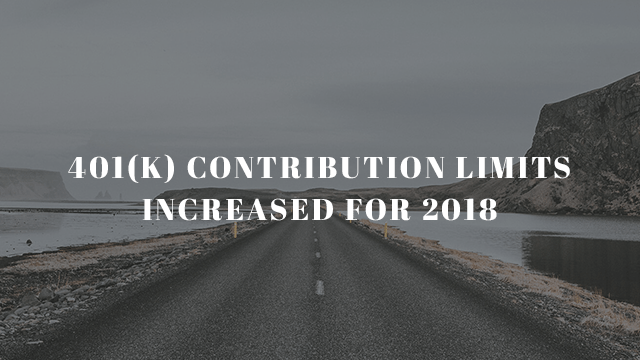
401(k) Contribution Limits Increased for 2018
Big News from the IRS
After two years without any changes, the IRS announced they will be increasing the 401(k) contribution limits for 2018. This is exciting news!
The increase in cost of living will allow individuals to contribute up to $18,500 ($500 increase) per year to their 401(k) retirement plan. Additionally, this increase will apply to other retirement accounts including 403(b) plans, most 457 plans, and Thrift Savings Plans (TSPs), however; the IRA and Roth IRA account contribution limits will not change. All employees should expect to see notifications from their employers about this increase.
Will This Really Make a Difference in the Long Run?
I always tell my clients that in order to grow their retirement savings significantly, they need to contribute as much as possible as young as possible. While an additional $500 per year may not sound like a major increase, ultimately these contributions will add up to a lot come retirement.
CNBC notes the significant difference of increasing your contribution to $500 each year, rather than simply putting an additional $500 in your savings account,
“As personal finance site NerdWallet points out, it could mean up to $70,000 more in your retirement account. The site calculated how much bigger your retirement fund would get if you started investing an additional $500 a year. It assumed a retirement age of 67 and a 6 percent annual rate of return. To give you an idea of just how powerful compound interest is, NerdWallet also highlighted how much money you’d have if you didn’t invest the $500 a year and simply kept it as cash:
- If a 30-year-old starts investing an extra $500 a year, it could mean an extra $70,212 in retirement, versus $18,500 saved in cash.
- If a 40-year-old starts investing an extra $500 a year, it could mean an extra $34,712 in retirement, versus $13,500 in cash.
- If a 50-year-old starts investing an extra $500 a year, it could mean an extra $15,202 in retirement, versus $8,500 in cash.”
How the Increase Positively Impacts Your Taxes
In addition to increasing your retirement savings, your taxable income will also be reduced when you contribute the additional $500.
If you have an employee contribution matching plan, a good rule of thumb is to contribute the maximum matching amount so you take full advantage and not leave any money on the table. However, if you can contribute more and maximize your 401(k) contributions each year (coupled with compounding interest), you’ll have a much larger retirement savings account.
Schedule a free call with us today if you have any questions regarding the increase in 401(k) contribution limits for 2018.








